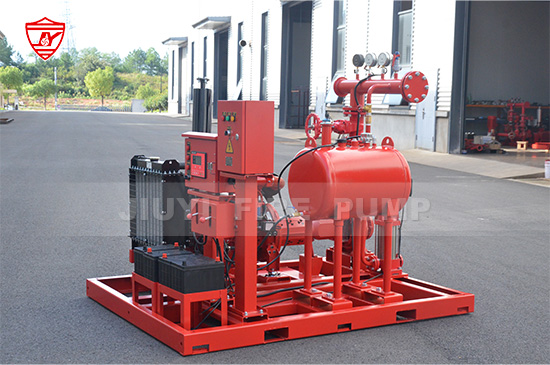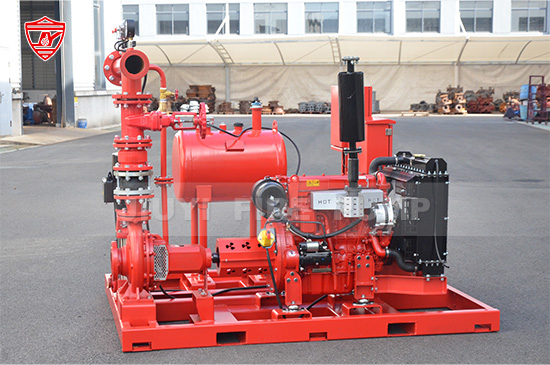Fire pumps are at the heart of any effective fire protection system. They provide the necessary water flow and pressure to fight fires when normal water supply systems cannot meet the demand. One of the most important—but often misunderstood—concepts in fire pump performance is churn pressure.
Understanding fire pump churn pressure is essential for system designers, installers, and maintenance engineers because it affects system reliability, safety, and compliance with standards such as NFPA 20. In this article, we’ll explain what churn pressure is, why it matters, how it’s measured, and what to look out for during design and operation.

Fire pump churn pressure (also known as shutoff pressure) refers to the maximum pressure a fire pump produces when operating with zero flow. In other words, it’s the pressure generated when the discharge valve is closed, and no water is leaving the pump.
At churn, the impeller continues to rotate, moving water inside the pump casing, creating pressure but no discharge flow. This is the highest pressure the pump will produce in its normal operating range.
According to NFPA 20 (Standard for the Installation of Stationary Pumps for Fire Protection), the maximum churn pressure should not exceed 140% of the rated pressure of the pump at its rated flow.
A fire pump’s performance follows a specific pump curve, which shows the relationship between flow (GPM or L/min) and pressure (PSI or bar).
At 0% flow (churn): The pressure is at its highest point.
At 100% rated flow: The pump delivers its rated pressure.
At 150% of rated flow: The pressure typically drops to around 65–70% of the rated pressure.
The pump curve helps engineers verify that the pump will meet system requirements under all operating conditions—from zero flow to maximum flow during a fire emergency.
Churn pressure is not just a theoretical value; it has practical and safety implications.
Excessive churn pressure can damage pipes, valves, fittings, and other components of the fire protection system. Keeping the churn pressure within the NFPA 20 limit ensures that the system operates safely even when the discharge valves are closed.
Operating at churn is not ideal for the pump. When water is trapped in the casing, it can lead to heat buildup, potential cavitation, and mechanical stress. Understanding churn pressure helps maintenance teams avoid long periods of no-flow operation that could harm the pump.
NFPA 20 sets strict limits on fire pump performance, including churn pressure. Pumps that exceed the allowed pressure at zero flow may fail acceptance testing or require additional pressure relief valves to comply.
In some scenarios, a fire pump might start automatically when system pressure drops, even if no sprinklers or hydrants are open. In these cases, the pump operates temporarily at churn. If the pressure is too high, it can lead to system leaks or equipment damage.
NFPA 20 provides clear guidelines to control churn pressure and ensure safe operation.
Maximum Churn Pressure: Should not exceed 140% of the rated pressure at the rated flow.
Pressure Relief Valve (PRV): If the churn pressure is higher than allowed, a pressure relief valve must be installed to discharge excess pressure safely.
Pressure Measurement: Churn pressure must be recorded during the factory test and acceptance test of the pump.
For example, if a pump is rated for 100 PSI at 1000 GPM, the maximum allowable churn pressure is 140 PSI. If the actual churn pressure is 150 PSI, a PRV must be used to bring it down within limits.
Measuring churn pressure is a standard part of both factory testing and field acceptance testing.
At the manufacturing facility, each pump undergoes a hydrostatic and performance test. The churn pressure is measured with the discharge valve closed, and the pump is operated at the rated speed. The results are plotted on the performance curve and included in the certification documents.
After installation, the fire pump is tested on-site under the supervision of the contractor, owner, or authority having jurisdiction (AHJ). The discharge valve is closed, and the pressure gauge at the discharge header is used to measure the churn pressure. This confirms that the installed system matches factory performance and NFPA 20 requirements.
Several factors can affect a pump’s churn pressure in the field, even if it meets standards at the factory:
Suction Supply Pressure: Higher incoming water pressure increases the total discharge pressure at churn.
Pump Speed: If the driver (electric motor or diesel engine) runs at higher speed than rated, the churn pressure increases roughly with the square of the speed ratio.
System Elevation: Static head differences in the piping system affect overall pressure readings.
Temperature and Viscosity: Higher water temperature can slightly reduce pressure generation, while cooler water can increase it.
System Modifications: Adding components like check valves or backpressure valves may change the overall hydraulic characteristics of the system.
If the measured churn pressure exceeds the NFPA limit, the system designer or maintenance engineer should investigate and correct the issue. Common solutions include:
Install a pressure relief valve on the discharge side of the pump. The PRV automatically opens when pressure exceeds a preset limit, allowing water to flow to a drain or return line until pressure returns to safe levels.
For diesel-driven or variable-speed electric fire pumps, slight speed adjustments may reduce churn pressure. However, this must be done carefully to ensure the pump still meets rated flow and pressure requirements.
If the system layout or elevation causes excessive static pressure, engineers may need to modify piping design, reduce elevation differences, or select a lower-rated pressure pump.
The PRV is a critical safeguard in systems where churn pressure could exceed safe limits. NFPA 20 requires it when:
The churn pressure at zero flow exceeds 140% of rated pressure.
The total discharge pressure (including suction pressure) exceeds system component ratings.
The PRV should discharge enough water to maintain safe pressure continuously while the pump operates at churn. It must be tested regularly to ensure functionality.
Monitoring churn pressure should be part of every routine fire pump maintenance program.
Weekly Fire Pump Test Runs: During no-flow weekly tests, check and record the churn pressure.
Compare with Baseline: If the pressure rises or falls significantly compared to previous records, it may indicate wear, impeller damage, or suction issues.
Inspect Relief Valves: Ensure the PRV operates smoothly and is free of leaks or blockages.
Calibration of Gauges: Pressure gauges must be accurate and recalibrated periodically.
Consistent monitoring helps prevent pump failure during emergencies and ensures long-term reliability.
Confusing Churn Pressure with Rated Pressure
Rated pressure refers to the pump output at rated flow. Churn pressure is always higher and occurs at zero flow.
Ignoring the Impact of Suction Pressure
When measuring total churn pressure, both discharge and suction pressures must be considered.
Neglecting Regular Testing
Failing to conduct weekly or monthly tests can result in unnoticed drift in pressure, potentially leading to unsafe conditions.
Improper Pressure Relief Settings
A relief valve set too high or too low can either fail to protect the system or waste water unnecessarily.

Understanding and controlling fire pump churn pressure is vital for the safe and efficient operation of fire protection systems. It represents the highest pressure condition your system will experience, and keeping it within NFPA 20 limits prevents equipment damage and ensures compliance.